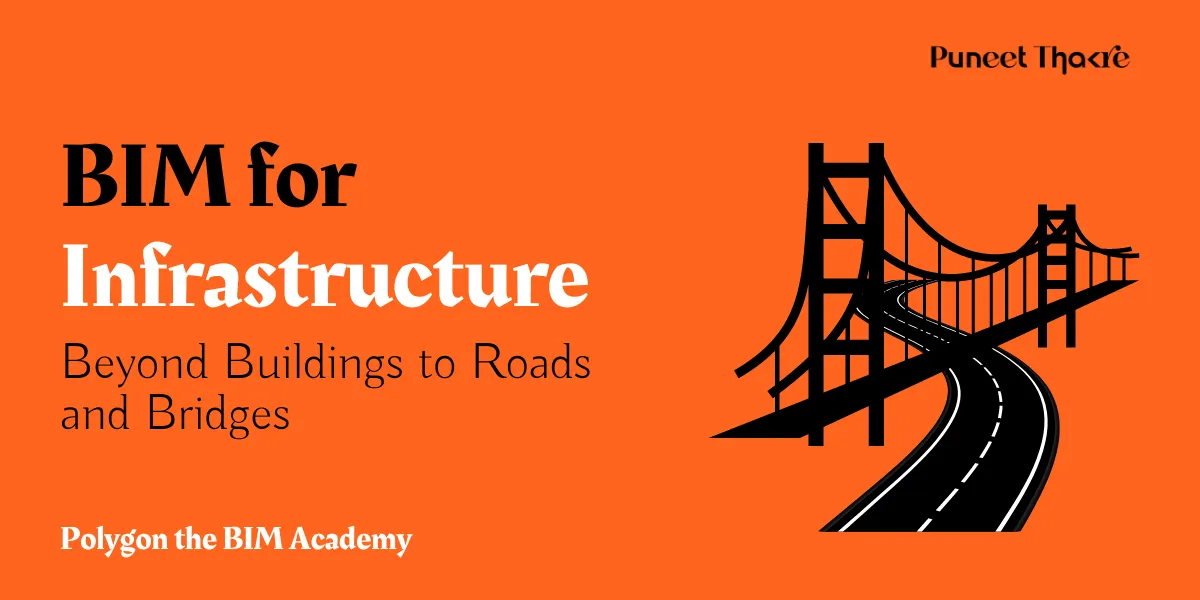#BIM for Infrastructure
Hey there, Architects & AEC Enthusiasts! 🌟
Ever scratched your head wondering why "Building" Information Modeling, or BIM, sounds like it's all about creating skyscrapers, apartments, or shopping centers? Well, you're not alone! Here's a little nugget of wisdom to kick things off: the "B" in BIM might stand for Building, but think of it more as a verb than a noun. It's not just about the final structure; it's about the act of making things. This tiny twist opens up a whole new world of possibilities where BIM stretches its wings beyond buildings to embrace the vast expanse of infrastructure projects, including our roads and bridges, and even monumental statues. Let's dive into how this powerful tool is shaping the future, one brick (or bit of data) at a time.
The Real Scoop on BIM and Infrastructure
So, why is BIM such a big deal for roads and bridges? Imagine you're playing the world's most sophisticated video game, where every choice you make affects the outcome. BIM lets architects, engineers, and builders do just that, but in real life. It helps everyone see the same picture, make smarter decisions, and avoid those pesky "I thought you meant..." moments that can cause delays and budget blowouts.
Why BIM for Roads and Bridges?
let's dive a bit deeper into these compelling reasons why BIM is the go-to for roads and bridges..
Crystal Clear Clarity
Ever tried putting together a puzzle only to find the picture doesn't match the pieces? That's what working with 2D drawings can feel like. BIM changes the game by bringing ideas to life with vivid 3D models that everyone can understand, no matter their technical background. It's like going from a black and white TV to full HD – suddenly, everything makes sense, and the entire team can see the project in all its glory, ensuring no detail is lost in translation.
Teamwork Makes the Dream Work
Picture BIM as the ultimate group chat for construction projects, but without the annoying spam. It's a platform where architects, engineers, and builders all get to chime in, share updates, and flag concerns in real-time. This collaborative spirit means projects run as smoothly as a well-oiled machine, with everyone pulling in the same direction. It's about breaking down silos and building up trust, ensuring that the left hand always knows what the right hand is doing.
Green is the New Black
In today’s world, being eco-friendly is more than just a trend; it’s a necessity. BIM is like having a sustainability consultant on your team, helping to make green decisions from the get-go. By simulating different scenarios, BIM allows for the meticulous planning of materials, energy use, and waste management, making sure every project leaves the smallest carbon footprint possible. It’s about creating infrastructure that doesn’t just stand the test of time but also respects our planet.
Safety First, Always
Imagine if you could foresee every potential risk on a project before it even starts. That's the power of BIM. By visualizing the construction process step-by-step, BIM allows teams to identify and mitigate risks early on, ensuring that safety isn’t just an afterthought. It’s a proactive approach to construction that keeps surprises sweet (like finding an extra cookie in your cookie jar) and not sour (like unexpected construction delays or safety incidents). With BIM, we’re not just building safer structures; we’re ensuring every worker gets home to their families at the end of the day.
Real Talk: BIM in Action
All around this big, beautiful world of ours, BIM is doing some pretty amazing things. It's like the quiet genius in the room, changing the game without making a big fuss about it. Let's zoom in on a few places where BIM has been a game changer.
Take, for instance, the sprawling highways that cut through mountains and forests, mimicking the natural curves of the landscape. These are not just roads; they're lifelines, connecting people and places. BIM plays a pivotal role here, making sure these highways blend with the environment, respecting nature while providing us with safe and scenic routes.
Then, there are the bridges – oh, the bridges! These marvels of engineering that stretch over rivers, valleys, and even seas, bringing communities closer. BIM helps in designing bridges that are not only feats of engineering but also works of art. It ensures that these structures can withstand the test of time and nature, from the strongest of winds to the mightiest of earthquakes.
But it's not just about the big, headline-grabbing projects. BIM is also making waves in less glamorous, but equally important, infrastructure endeavors. Think about water management systems that ensure our cities don't flood during a storm, or the electrical grids that power our homes and lives. BIM is there, behind the scenes, making sure these systems work seamlessly and sustainably.
Let's Chat & Build a Better World Together
So, there you have it! BIM is breaking down barriers, showing us that it’s not just about buildings; it’s about the act of making a difference in our world. Whether it’s roads, bridges, or even monumental statues, BIM is here to stay, transforming our landscapes and our lives.
Got a story to share about how BIM has transformed your projects? Or maybe a question about diving deeper into BIM for infrastructure? Drop a comment below! Let’s keep the conversation going and build a better, brighter world together.
FAQs: BIM for Infrastructure
Q: Can BIM be used for any type of infrastructure project?
A: Absolutely! While BIM might sound like it's all about buildings, its magic extends far beyond. From highways and bridges to tunnels and dams, BIM can be applied to virtually any infrastructure project. It's all about making the construction process more efficient, no matter the type or size of the project.
Q: How does BIM change the way infrastructure projects are planned?
A: Imagine being able to see your project in 3D before even breaking ground. That's what BIM offers – a detailed digital blueprint that brings every aspect of the project to life. This means better planning, as potential issues can be spotted and solved early on, ensuring that the project runs as smoothly as a scenic drive on a newly laid road.
Q: What are the benefits of using BIM for roads and bridges specifically?
A: For roads and bridges, BIM is a game-changer. It enhances design accuracy, improves coordination among diverse teams, and streamlines the construction process. Plus, it plays a huge role in maintenance and operation, providing a comprehensive digital record that can be referred to for years to come. It's like having a roadmap that guides not just the construction but the entire lifecycle of the infrastructure.
Q: Does BIM integration in infrastructure projects require special software or training?
A: Yes, diving into BIM does mean getting to grips with specialized software, and a bit of training is needed to make the most of its capabilities. But don't let that deter you! Many software providers offer training, and the investment in time and learning pays off massively in terms of project efficiency, safety, and sustainability.
Q: Can small firms or local governments afford to implement BIM in their infrastructure projects?
A: While there's an upfront cost to adopting BIM, the return on investment can be substantial. For small firms and local governments, BIM can lead to significant savings in the long run by reducing construction errors, shortening project timelines, and lowering maintenance costs. There are also scalable BIM solutions available that can fit a range of budgets and project sizes.
Q: How does BIM support the sustainability of infrastructure projects?
A: BIM goes hand-in-hand with sustainable design by allowing for more precise material estimates and waste reduction, optimizing energy consumption, and ensuring that new infrastructure blends harmoniously with the environment. It’s about building not just for today, but for a greener tomorrow.





